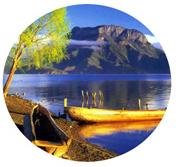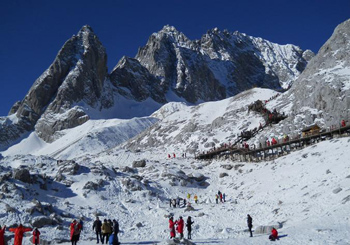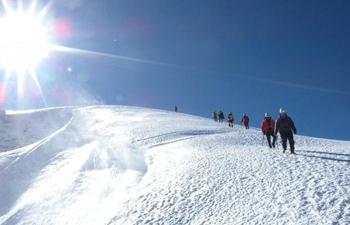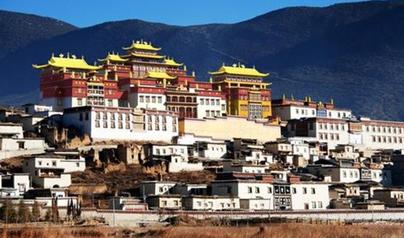Yunnan Adventure to Jade-Dragon Mountain and Haba Mountain
|

|
|
Yunnan Adventure: 10-day
Haba Snow Mountain(5536m) Climbing
with Tiger Leaping Gorge Trekking Tour
Highlights:
� For those who love the outdoors and a challenge, than
this is the perfect adventure hike for you. You�ll get to climb
Haba Snow Mountain, and you�ll be accompanied by a professional
mountaineering guide as well as yaks! You�ll also get to trek
through Tiger Leaping Gorge, one of the world�s most impressive
gorges, as well as being widely considered the best hike in
China
� You�ll be immersed in the diverse and fascinating ethnic
minority culture (such as the Naxi and Bai peoples) of Yunnan,
visiting authentic minority villages and towns, which will give
you insight on the day-to-day life of these intriguing ethnic
groups
� Visit the town of Shangri-La, which was once thought only to
exist in legend. This real-life paradise will enchant you with
its Tibetan tradition, grand monasteries, and above all it�s
people, and you�ll get to visit and have dinner in the home of a
Tibetan family in the town
B=(Breakfast) L=(lunch) D=(dinner)
DEPARTURE: Daily |
|
|
| |
TOUR ITINERARY |
 |
Tour code:
AYN-09 |
|
Day 1: arrive in Lijiang
You will fly to the town of Lijiang, and
upon arrival you�ll be met by your English-speaking guide.
Lijiang is an enclave of ethnic minority cultures, and the
Naxi ethnic group is especially prevalent here. You will be
taken to your hotel in Lijiang, and you�ll have the evening
to unpack and relax. If you like, you can spend the night
walking along the Old Town of Lijiang.
The Old Town is made up of three old districts that retain a
special character of Naxi and Han construction and Naxi
customs, arts and culture. It was a former trading town and
a stop for traders carrying goods on the �Chama Road�
trails. It was listed as a UNESCO World Heritage Site in
1997 following an earthquake and reconstruction in 1996 that
returned the city to a more ancient look. The UNESCO
description says: �The Old Town of Lijiang, which is
perfectly adapted to the uneven topography of this key
commercial and strategic site, has retained a historic
townscape of high quality and authenticity. |
Day 2: Lijiang-Jade Dragon Snow
Mountain-Lijiang (B)
Today we will be exploring Jade Dragon
Snow Mountain, which dominates the landscape of Lijiang. The
Jade Dragon Snow Mountains are a small group of peaks close to the city of
Lijiang. The nearest slope is only about 30 kilometers north
of the Dayan Ancient City District, and the mountain can be
clearly seen from the Black Dragon Pool next to the ancient
district. The group of mountains is notable because they
contain a small ski area, good hiking along Tiger Leaping
Gorge, great scenic views, and a 15,000 foot mountain with a
specially built stairway and path to make climbing to the
summit easy. Looking from Lijiang Old Town in the south,
which is 15 kilometers (nine miles) away, the snow-covered
and fog-enlaced mountain resembles a jade dragon lying in
the clouds, hence, the name Jade Dragon Snow Mountain.The
Yangtze River runs through Tiger Leaping Gorge in the valley
below. The mountains are a place to go to in Yunnan for
skiing or fun in the snow in the winter and for hiking and
enjoying the natural scenery the rest of the year.
Mountains are a small group of peaks close to the city of
Lijiang. The nearest slope is only about 30 kilometers north
of the Dayan Ancient City District, and the mountain can be
clearly seen from the Black Dragon Pool next to the ancient
district. The group of mountains is notable because they
contain a small ski area, good hiking along Tiger Leaping
Gorge, great scenic views, and a 15,000 foot mountain with a
specially built stairway and path to make climbing to the
summit easy. Looking from Lijiang Old Town in the south,
which is 15 kilometers (nine miles) away, the snow-covered
and fog-enlaced mountain resembles a jade dragon lying in
the clouds, hence, the name Jade Dragon Snow Mountain.The
Yangtze River runs through Tiger Leaping Gorge in the valley
below. The mountains are a place to go to in Yunnan for
skiing or fun in the snow in the winter and for hiking and
enjoying the natural scenery the rest of the year.
By cable car and by foot we�ll visit all the scenic spots of
Jade Dragon Snow Mountain, and we�ll also go by cable car to
the mountain�s peaks. The highest peak is named Fan Peak(Shanzidou
in Chinese) which is about 5596 meters above sea level.
Other notable area we will visit by cable car are the
Glacier Park(4500M), the Spruce Meadow(3200M), and the Yak
Meadow(3700M). Afterwards you�ll get to view the Lijiang
ethnic Culture Show, a song and dance extravaganza about the
regions numerous minority cultures, and the show was created
and directed by Zhang Yimou (he also directed the 2008
Beijing Olympics Opening Ceremony).
In the afternoon you�ll have the opportunity to get better
acquainted with the Naxi people at the village of Baisha.
Baisha Old Town is one of the oldest towns in Lijiang. It is
the earliest settlement of the Naxi people and is the
birthplace of "Tusi", chief of the Mu clan. In the town
there are many ancient buildings built during the Ming
Dynasty, including Dabaoji Palace, Liuli Temple, and
Wenchang Palace. The well-known Baisha Frescoes are located
in Dabaoji Palace. Because of the white sand on the ground,
the town was named "Baisha", which means "white sand". In
the Naxi language, it is called "bengshi". The architectural
complex is made up of two parts, folk residence and cultural
sites. The folk residence is called "pengshizhi" which in
the local language means "Baisha Streets". The streets all
go from south to north. In the center of the old town there
is a square where three thoroughfares intersect. Houses and
small stores stand on the both sides of these streets. A
crystal clear stream winds around all the houses flowing
through the small town from north to south.
The center of town features a beautiful rendering of
frescoes religious frescoes. The 44 pieces of Baisha frescos
were drawn in the early Ming Dynasty. Most of the paintings
are about religious stories of Taoism, Buddhism, and Tibetan
Buddhism. The murals embody the artistic characteristics of
the Naxi, Tibetan, Han and Bai ethnic groups. Among them the
paintings about Kwan-yin and Sakyamuni are the most famous
ones. Now Baisha Frescos, also known as Lijing Frescos have
become precious data for the study of China's history of
arts and religions.
We�ll then return to Lijiang for the evening. |
Day 3:
Lijiang�Qiaotou (1800m)-Halfway Guesthouse (2500m) (B, L, D)
Today we are going to get started on our hike through Tiger
Leaping Gorge. Tiger Leaping Gorge is one of the world�s
deepest gorges, and is tucked in between Jade Dragon Snow
Mountain and Haba Mountain. At a length of 17km, Tiger
Leaping Gorge is the birthplace of the ancient Lijiang
culture, whose people lived in the many caves, big and
small, in the side of Yulong Xueshan (Jade Dragon Snow
Mountain). These caves were naturally formed houses. In some
caves, rock paintings and artifacts shedding light on the
life of these primitive peoples were found. The rock
paintings have now become another attraction of Tiger
Leaping Gorge. The gorge is regarded as one of the top ten
hiking trails in China.
At 6 in the morning we will drive (2 hour drive) to the town
of Qiaotou, which is where we�ll begin our trek. We�ll hike
for two hours, and then stop for lunch at a Naxi family
restaurant, and here we�ll try some Naxi cuisine.
We�ll then resume our hike, continuing to hike another 2
hours up the steep switchback called �28-bends before the
next break�. The views are unforgettable (you are at an
altitude of over 3000m). After a break, we�ll hike another
one or two hours, and then we will arrive at the Halfway
Guesthouse, which has a great view of Yulong Snow Mountain
and overlooks the Jinsha (Golden Sands) River Valley. You
can sit out on a deck facing the mountain, and there are hot
showers and clean beds. |
Day 4: Halfway Guesthouse
(2500m)-Tina�s Inn-Middle Rapids (1800m)-Haba Village
(2600m) (B, L, D) (5-6 hours of hiking)
We�ll rise early in the morning, and
we�ll continue hiking for about 2 hours until we reach
Tina�s Inn, and we�ll spend about an hour there to have a
break and a meal. Around mid-day we will reach the steep
cliffs of Middle Tiger Leaping Gorge, along the bank of the
Jinsha River. At this point we will visit the narrowest
point of the gorge, where it is said that a tiger could
easily jump over the Jinsha River, hence the gorge�s name.
It is a tight spot with the whole of the Yangtze River
confined to a 20-meter (70-foot) width.
We�ll then climb up the gorge to Walnut Grove (Woody�s
Guesthouse), and depending on how tired you are, we�ll go
via either the Tianti or Yixiantian route. After we reach
Walnut Grove Garden, we�ll take the car to Haba Village, and
after dinner, we�ll make our preparations for climbing Haba
Snow Mountain
We�ll spend the night at the Haba Mountain Guesthouse. |
Day 5: Haba Village (2600m)-Base
Camp of Haba Snow Mountain (4200m)

Today we will begin our trek up Haba
Snow Mountain. The Haba Snow Mountain, with its main peak
5,396 meters in height, also has a climate that is
distinctly different from the foot to the summit because of
elevation difference, and it has a temperature difference of
up to 22.8 degrees. The Haba Snow Mountain covers 21,908
hectares, and is covered with a vertical distribution of
forests. The attraction of the Haba Snow Mountain is
attributed to the towering peaks and its alpine moraine
lake, along with endless tracks of azalea flowers.
Besides snow mountains, lakes and azalea flowers, there are
also many waterfalls here. Tumbling down the northeastern
side of the mountain is Haba Waterfall, also known as the
"Great Hanging Water", which is more than 200m high and
pours down with an amazing momentum.
The mountain area is the final home to many species. There
are many kinds of plants, animals in the snow mountain, and
is therefore praised as the Natural Zoo.
We�ll trek up the mountain for about 15km, and your luggage
will be carried by the bellhops of Haba Snow Mountain, yaks!
For lunch we will have a picnic meal during a respite from
our hike.
After a few hours of hiking we�ll arrive at the Haba Snow
Mountain Base Camp, and we�ll camp here in our tents for the
night. |
Day 6: Haba
Snow Mountain Base Camp (4200m)-Camp 1of Haba Snow Mountain
(4800m) (B, L, D)
Today we�ll be continuing our hike up Haba Snow Mountain.
We�ll climb up another 6km, and the hiking up here is a
little more difficult and challenging, so it will take us
about 6 hours. You�ll be with your own professional
mountaineering guide, and he/she will pick the most
efficient climbing route possible. However, you will need to
carry your own luggage today (sorry, no yaks!). For lunch
we�ll have another picnic, and the mountaineering guide will
set up camp for the night. |
Day 7: Camp 1 of Haba Snow
Mountain (4800m)-top of Haba Snow Mountain (5396m)-Haba
Village (B, L, D)
We�ll get up bright and early today at
5, and you�ll get a magnificent view of the sunrise. We�ll
then set to work on getting to the top of the mountain. This
final leg of the climb will be 4km and will take about 5
hours. You�ll be able to leave most of your luggage at Camp
1, and you�ll just need to take your mountaineering
equipment, such as your rope, ice ax, and ice pick. We�ll
then arrive at the top (you did it!) and we�ll take some
time to marvel at our achievement.
We�ll set up a picnic for lunch, and then hike down to Camp
1 in order to get your luggage. Afterwards, we�ll hike down
to the base camp, and after all that hard work and
perseverance you�ve put in, the cook at Base Camp will have
something hot and delicious waiting for you.
We�ll stay at the Base Camp for the night. |
Day 8 Base Camp of Habba Snow Mountain (4200m)-Haba
Village-Baishuitai-Shangri-La (3300m) (B, L, D)
In the morning we will trek down from the Base Camp to the
Long Wang Bian Village, with yaks taking your luggage. After
lunch, we�ll drive on to Shangri-La (also known as
Zhongdian), which is located in northwest Yunnan, and is in
close proximity to Tibet. On the way there we will stop at
White Water Terrace, which is known in Chinese as
Baishuitai. White Water Terrace in Naxi (the local ethnic
minority group) means 'growing flower'. Not only a place of
beautiful scenery, it is also one of the birthplaces of
Dongba Naxi culture, which is widely known around the world.
It is said that the founding father of Dongba culture
settled here to spread his beliefs on his way back from
Tibet. On the eighth day of the second month of the lunar
calendar, that is, the day when the founding father held his
founding ceremony, people of various groups congregate round
the terrace, singing and dancing and slaughtering chickens
to pay tribute. White Water Terrace occupies an area of
about 3 square kilometers with green plants and springs
setting off each other, and is just like a "field in
heaven".
We�ll then drive the final 100km in order to reach
Shangri-La. The mythical, yet real, Shangri-La, is the basis
of much legend. The English writer, James Hilton�s legendary
novel �Last Horizon� wowed readers with a paradise,
characterized by snow-capped mountains, vast grasslands,
lush vegetation, gorgeous gorges and idyllic lakes, and that
is exactly what you�ll find when we arrive.
When we arrive in Shangri-La we�ll go for a stroll in the
old town of the city, which is known as Dukezong. It is
located in the southeast section of Shangri-La, and has a
history dating back over 1300 years. Almost all the
buildings are white in color and feature the Tibetan style
architecture. You�ll find busy markets, colorful homes, and
the trace of Tibetan culture will be unmistakable. |
Day 9 Shangri-La (B)
Following breakfast we�ll get started on some Shangri-La
sightseeing, and we�ll first visit the Ganden Sumtseling
Monastery. Being the
largest Tibetan Buddhist monastery in Yunnan, Songzanlin
Monastery, also known as Guihua Monastery, is one of the
famous monasteries in the Kang region. Construction of the
monastery began in 1679 and was completed two years later.
The monastery seems like a group of ancient castles and is
composed of two lamaseries, Zhacang and Jikang. The gilded
copper roof endows the monastery with strong Tibetan
features and the 108 (an auspicious number in Buddhism)
columns downstairs also feature the monastery with
characteristics of Han nationality. The main halls in the
monastery are magnificent, and on both the left and the
right sides are wonderful frescos, depicting Buddhist tales
and legends. The inside-halls are exquisite with cloisters
running through. The cloisters are all decorated with
beautiful sculptures and consummate frescos. the
largest Tibetan Buddhist monastery in Yunnan, Songzanlin
Monastery, also known as Guihua Monastery, is one of the
famous monasteries in the Kang region. Construction of the
monastery began in 1679 and was completed two years later.
The monastery seems like a group of ancient castles and is
composed of two lamaseries, Zhacang and Jikang. The gilded
copper roof endows the monastery with strong Tibetan
features and the 108 (an auspicious number in Buddhism)
columns downstairs also feature the monastery with
characteristics of Han nationality. The main halls in the
monastery are magnificent, and on both the left and the
right sides are wonderful frescos, depicting Buddhist tales
and legends. The inside-halls are exquisite with cloisters
running through. The cloisters are all decorated with
beautiful sculptures and consummate frescos.
Then it is off for some relaxation at the Pudacuo Nature
Reserve. This is a protected wetlands area that has a
primitive forest of coniferous trees lakes, and lies 3,539
meters above sea level. Two lakes that accentuate the beauty
of this park are the Shuda Lake and the Bita Lake. We will
then follow this up with a visit to the Summer Pastures at
Napa Lake, right outside Shangri-La.Several rivers flow into
the lake, including the Naizi and Naqu Rivers. The lake is
seasonal in that it is dry in the fall and winter seasons,
naturally becoming part of the Yila Prairie. During this
time, visitors can see many sheep and cows grazing in the
lakebed.
Afterwards we�ll return to the old town of Shangri-la for a
bit before going over to Guishan Park, a lovely preserve
with a temple one top that gives you a sweeping panoramic
view of the entire city.
In the evening, you�ll get to have some firsthand experience
in the Tibetan culture of the area by visiting the home of a
local Tibetan family, and if you�re a good guest (and we�re
sure you will be!), you�ll get to try some yak butter tea
(yummy!), and even take part in some Tibetan dancing! |
Day 10 Shangri-La-Kunming-departure (B)
In the morning you�ll be taken to the airport, and you�ll
make the short flight to Kunming, the capital city of Yunnan
province, and from Kunming you�ll fly on to your next
destination, thus ending the tour. |
|
Stuff to bring:
� Sturdy shoes or boots, sunglasses and sunscreen
� Bug spray and any other items needed in dealing with the tropical heat
� Tips for a job well done by your guides and drivers, money for any
personal expenses not mentioned
|

